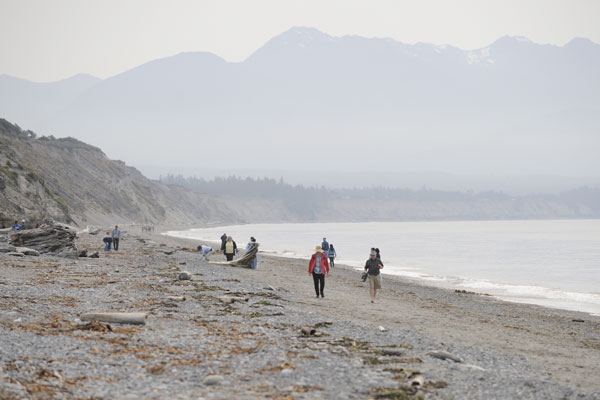The U.S. Fish and Wildlife Service (Service) has formally adopted its new plan for the Dungeness National Wildlife Refuge, which includes the 5-mile Dungeness Spit. It contains two changes from the controversial draft plan — two compromises — but the changes aren’t likely to assuage everyone’s concerns. The Comprehensive Conservation Plan, which will guide management of the refuge for the next 15 years, now says jogging will continue to be allowed on the site, as will horseback riding. Both, however, are subject to new restrictions.
The initial draft, released in late 2012, would have banned both. The Service received 183 comments on the draft plan, many of them critical of the bans.
Jogging trails
Under the new plan, jogging will be allowed along a half mile stretch of beach below the bluffs west of the spit. Jogging also will be allowed on the trail adjacent to the parking lot.
No jogging will be allowed on the spit.
In response to critical comments, the Service said that while the impact of jogging on the wildlife population hadn’t been studied in detail, “impacts have been reported from refuge staff, volunteers and visitors including wildlife disturbance on the forested trail and beach, and conflicts between user groups.”
Horseback riding
In its response to other comments, the Service said that horseback riding isn’t one of the “six priority wildlife-dependent public uses identified in the National Wildlife Refuge System Administration Act.”
Project leader Jennifer Brown-Scott noted that in May 2012 a meeting of a pedestrian and a horseback rider led to a serious accident on one of the upland trails and that the new plan seeks to reduce the possibility of further accidents.
The Service will now allow horseback riding along the same half-mile stretch of beach near the parking lot, but there’s a catch: there’s no way to access the beach on horseback. The plan says horseback riders will first be required to obtain a “safe and legal alternate access route … from the west or from the east.”
Under one possible scenario for implementing the plan, individuals or groups could work with private landowners to seek their own safe and legal access route to the refuge.
Alternatively, the Service would need to acquire additional refuge lands through fee or easement acquisitions or through “cooperative agreements.”
The Service investigated alternative solutions, including building a separate equestrian trail, installing railings or requiring riders to dismount and walk their horses, but determined none are workable.
Environmental focus
The Service says there is a new focus on enhancing the public’s understanding and appreciation of the refuge’s natural and cultural resources through both on- and off-refuge interpretation and education programs.
The Service also is calling for more active habitat management projects, including invasive species removal. The plan calls for removing unneeded roads, increasing species diversity and enhancement of freshwater impoundment on the Dawley unit.
The full plan can be found at www.fws.gov/pacific/planning.
Reach Mark Couhig at mcouhig@sequimgazette.com.



